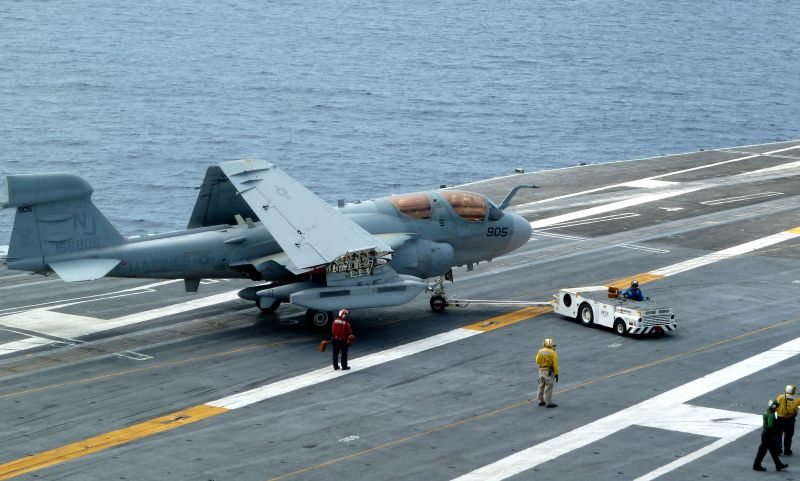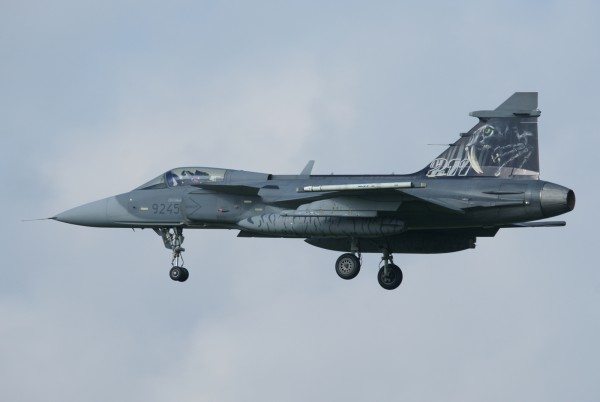An Air Force electronic warfare officer recently became the first to upgrade and become a fully qualified instructor teaching Navy pilots flight maneuvers in the EA-6B Prowler.
Maj. Martin Rann, an EA-6B Prowler instructor assigned to the Fixed Wing Electronic Attack Squadron 129, is attached to the 390th Electronic Combat Squadron at Mountain Home Air Force Base, Idaho.
“It is such an honor to be an instructor teaching these young lieutenants how to fly and land the Prowler on carriers,” Rann said. “This is something I have wanted to do for a long time and one of the main reasons I made the decision to return to Naval Air Station Whidbey Island, Wash., and be a part of the boat program.”
Rann arrived at NAS Whidbey Island in July 2010 after earning his bachelor’s degree while enlisted in the Marine Corps. In 1999, he submitted a package for Air Force Officer Training School and was accepted. He then went to flight school inPensacola, Fla., in September 1999. He began his instructor upgrade training in November 2010.
“Usually during training a more senior officer who has more flight hours and boat experience flies with the junior officer to assist and instruct,” Rann said. “The ranking officers have usually done a few fleet tours and have a lot of boat experience.”
The Prowler has two cockpits and seats up to four people. Trainers sit in the front passenger seat while training the pilots on the specifics of takeoff and landing.
“We practice landing ‘traps’ where we fly with the hook down and catch the wire to land quickly and safely,” Rann said. “Also, there is a ‘cat’ which is short for catapult, the Prowlers basically slingshot off the ships. We train the pilots to cat and trap in both day and nighttime situations.”
Rann said there are significant differences between being an F-15E Strike Eagle and an EA-6B Prowler pilot. For example, the Prowler is a tactical jammer used in more of a support role. By jamming enemy radar and communications, they confuse the enemy and provide support to assault fighters like the Strike Eagle. But there is one distinct similarity.
“The F-15E Strike Eagles at Mountain Home (AFB) also have a hook, but it is mainly for emergency landings,” Rann said. “If someone loses their hydraulics and doesn’t have any brakes they can drop the hook, catch the wire and still land relatively safely. However, the traps on the ships will really stop you quickly, a lot quicker than the ones on the ground.”
During landing specific training sorties an area of land is painted “carrier box style,” which means it is painted to the specific ship landing area dimensions. The training pilots who have enough gas after a sortie or mission will practice landing a few times there. Later, students practice landing on a ship with a landing signals officer who actually talks the pilots down.
“It is a completely different sensation when you land on a ship,” Rann said. “There isn’t a lot of braking and driving around. You basically hit the deck, the hook grabs the wire and you snap to a stop real quick. If students miss the wire, they are taught to land at near full power so they can take back off and circle around for another try. It’s a lot of fun.”
Senior leaders said they are very impressed with Rann’s ability to provide excellent training to his students.
“In our squadron’s history, we have never had anyone like Major Rann who could do this kind of thing,” said Lt. Col. Carlton Keen, the 390th ECS director of operations. “The Navy is phasing the Prowler out by 2015 and replacing it with the EA-18G Growler. Major Rann is pretty much the last of his kind.”











